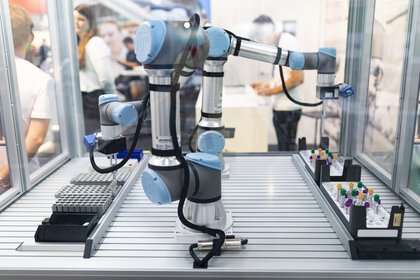Lab 4.0: How the laboratory world is going digital
analytica brings the digital transformation of the laboratory world to life. From March 24 to 27, 2026, in Munich, step into Lab 4.0 and learn about intelligent analyzers, smart lab technology and networking solutions for the lab of the future.
Intelligently networked: new tools for the Digital Lab
In Lab 4.0, digitalization delivers efficiency. With smart, networkable lab equipment and automated workflows, digitalized labs stay ahead of ever-increasing demands.
analytica invites you to Laboratory 4.0. Find out which digital tools help you save costs, time and resources - and at the same time increase the quality of your analyses. Exhibitors and scientists from all over the world will be presenting their innovations at the world's leading trade fair in Munich.
Study 'AI in the Laboratory' available for free download
You can download the joint publication of the German industrial association SPECTARIS and Messe München here:
Laboratory digitalization - the top topics at analytica
analytica is your number one event for laboratory digitalization. Look forward to exploring these top topics:
- Lab 4.0: more efficiency and flexibility in the lab of the future
- Robots and cobots: laboratory automation for digital transformation
- Connectivity: standard interfaces for laboratory networking
- Virtual Reality: how to expand the laboratory world
Plus, at analytica you will experience the whole spectrum of instrument developments and state-of-the-art laboratory technology for Lab 4.0:
- digital transformation of the laboratory world - Lab 4.0 - intelligent laboratory technology - voice control - personalized workflows
- automation - device communication - laboratory robots - cobots
- networking - standardization of interfaces - Laboratory Agnostic Device Standard (LADS) - OPC UA LADS
- sample logistics - barcodes, RFID tags etc. - traceability
- augmented reality - virtual reality - smartglasses in the digital lab
- Big Data - data validation - artificial intelligence - cloud computing - Internet of Things - IT security
- LIMS - laboratory software - electronic laboratory books
Talk to industry leaders in laboratory digitalization
Renowned exhibitors present the latest products and services for the lab of the future (Laboratory 4.0) at analytica.
At analytica 2024, for example, there were:
Lab 4.0: more efficiency and flexibility in the lab of the future
Efficient workflows are essential for the competitiveness of any laboratory, as this is the only way to cope with the increasing demands imposed by various factors, including new legal regulations Automated laboratory processes and optimized workflows reduce the workload of laboratory personnel. The software and hardware in Lab 4.0 is also designed to be modular and flexible enough to respond quickly to users' individual requirements and to varying sample volumes.
Processes that can be controlled via the smartphone facilitate daily work in Lab 4.0, as does the cloud-based management of all lab data.
As the quality of analysis results remains paramount, digital tools already play a key role in the collection, evaluation and storage of measurement results. Artificial intelligence is becoming more and more important in managing data glut.
Robots and cobots: laboratory automation for digital transformation
Lab 4.0 is highly automated. The advantages are obvious: automated processes compensate for the shortage of skilled workers and allow high sample volumes to be handled quickly. At the same time, automation makes the laboratory safer, by reducing the risk of injury and contamination.

Automated processes and laboratory robots really come into their own when dealing with hazardous substances, pathogenic germs and harmful chemicals, but even in trace analysis, manual sample contact should be kept to a minimum to avoid contamination. Automation is also a real boon for work steps that require extreme precision.
While routine processes such as pipetting can be completely automated, other laboratory processes use cobots that work hand in hand with humans. Automation and networking solutions are also indispensable for the desired 24/7 operation.
Connectivity: standard interfaces for laboratory networking
In the intelligent laboratory of the future, analytical and laboratory devices, sensors, processes and data are networked with each other and with all players in the laboratory world. These networks are controlled by laboratory information management systems (LIMS) and, increasingly, by cloud-based solutions.

It is crucial that all laboratory data is kept in a single location, with IT security measures in place, and is easily accessible to other systems, laboratory personnel and external users, such as customers or authorities.
Comprehensive integration in Lab 4.0 relies on standardized interfaces. All devices must have compatible network access and drivers so they can communicate with each other, their users and the cloud. Systematic digital transformation of the laboratory is not confined to analytical equipment and laboratory technology, but incorporates all data streams, workflows, software and hardware as well as people with their expertise and knowledge. The usual mix of devices made in different years by various manufacturers presents laboratories with a particular challenge.
The OPC UA (Open Platform Communications Unified Architecture) standard established for industrial automation forms a good basis for laboratory networking. analytica brings you up to date on the Laboratory Agnostic Device Standard, or LADS for short, which complements OPC UA.
Virtual Reality: how to expand the laboratory world
Individually designing and optimizing laboratory environments, simulating and improving analysis processes, practicing and assimilating individual steps: Virtual reality technologies are expanding the realm of routine laboratory analysis and diagnostics. Plus, they visualize research results. As well as viewing their microscopic images on the screen, soon cell biologists will be able to take a virtual stroll around the interior of their objects of study. And that's just one example.

Augmented reality glasses also offer helpful features for the digital lab. They can give lab staff instructions on workflows and automatically record the steps performed at the same time. Moreover, smartglasses can detect errors in the workflow and display warnings. Sample information and safety instructions when working with critical chemicals can also appear automatically in the viewer's field of view.
Analytics news with a plus: analytica-world news
analytica-world news is the industry's leading newsletter. It keeps you up to date 365 days a year in the field of laboratory technology, diagnostics and biotechnology. You want to stay up-to-date? Then subscribe to our free weekly newsletter directly online.
Unique supporting program round the laboratory of the future
On top of the actual trade show, our extensive suppporting program offers unique insights into the latest theory and practice in lab 4.0.
Forum: Digital Transformation
The new “Digital Transformation” forum in Hall B2 will offer product presentations and expert talks as well as panel discussions round big data, chemometrics and bioinformatics on all trade show days. Renowned researchers from Germany and abroad will provide a concentrated overview of novel methods and techniques as well as their practical applications.
More about the “Digital Transformation” forum
Special show: Digital Transformation
See our new Action Area at the newly conceived special show “Digital Transformation”. At hands-on islands you cannot only see workflows at the laboratory, but also get involved in them yourselves, to discover the latest trends of digitalization.
FAQs on laboratory digitalization
The term Lab 4.0 is derived from Industry 4.0, the synonym for the fourth industrial revolution. What it means is: digitalizing and automating all processes as much as possible. In Lab 4.0, the spectrum ranges from the digital capture of incoming samples to the automated evaluation and storage of data. Laboratory digitalization relies on standardized interfaces that enable all devices to communicate fully with each other and to network with management systems, other software and hardware, as well all human actors in the value chain. Artificial intelligence and cloud-based data management are playing an increasingly important role in the digitalized laboratory of tomorrow.
The advantages of laboratory digitalization and automation are manifold: automated processes compensate for the shortage of skilled workers and allow high sample volumes to be handled quickly. At the same time, automation makes the laboratory safer, by reducing the risk of injury and contamination.
Automated processes and laboratory robots really come into their own when dealing with hazardous substances, pathogenic germs and harmful chemicals, but even in trace analysis, manual sample contact should be kept to a minimum to avoid contamination. Laboratory automation also increases the reliability of analysis and research results. Partially or fully automated processes are less prone to errors and are also more transparent and easier to trace. Automation also allows contract laboratories to respond more flexibly to varying sample volumes. analytica is a one-stop-shop for information about the potential and benefits of digitalization and automation. Learn how to make lab processes more efficient while reducing the workload of lab staff.
Laboratory robots can take over repetitive steps and routine procedures. They are also used in high-throughput screening, enzyme assays and related applications. Good automation solutions already exist for activities such as pipetting and microplate handling. Autosamplers have also long been available on most analyzers. Increasingly, sample preparation, such as dilution and addition of reagents, is also being automated.
In addition to such automation solutions, there are adaptive cobots that work hand in hand with laboratory personnel and take over certain work steps. Robots are also particularly helpful when handling hazardous substances and for activities that require extreme precision.
It is generally accepted that robots cannot replace humans, and this goes for labs too. They relieve laboratory personnel and take work off their hands, but not away from them. In the future, it is likely that no human will have to perform repetitive, monotonous and easily automated tasks. Instead of spending hours pipetting or labeling tubes, lab workers can devote their time to more value-added and creative activities. However, no one can accurately predict how the laboratory world will change going forward as a result of artificial intelligence and robots that are self-learning and autonomous, because the digital transformation has only just begun.






